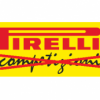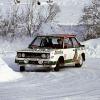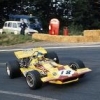Good question, as it highlights couple of major changes in Grand Prix racing over the years.
One is reliability. During the '62-65' years, for example, Clark's Lotus 25 and 33s was the pacesetter, but they often broke down, as was normal back in those days. Had Clark enjoyed the reliability that Vettel has now and Schumacher had in his five championship years at Ferrari, he would've had a statistically equally impressive record as those recent top drivers.
At Kyalami back in 1967 Rodriguez qualified fourth. The front row was an all-Brabham affair, but both Hulme and Brabham had problems during the race. Third on the grid was Clark, in the Lotus 43 with the H16 engine from BRM - which broke, as it used to, when installed in Clark's car, in this instance at quarter distance. So in this instance, Rodriguez Cooper T81-Maserati wasn't the fastest car, it was merely the fastests of the survivors. Not unusual in those days to have a slower car come out on top in a race of attrition, as witnessed by wins like Trintignant at Monaco '55 or Bandini at Zeltweg in '64. The last example, I can recall, was when Panis won at Monaco in a Ligier in the mid-90s.
The secon point is technical diversity, which meant some cars were more competitive on certain types of circuits than on others. An example was the 1953 Maserati, which due to its marginally stronger engine matched the Ferrari 500 at faster circuits as Reims and Monza, but was inferior to the Ferrari on circuits with more turns, as its rigid rear axle made its handling inferior to the Ferrari which had a De Dion rear suspension.
Another example is the splendid McLaren M23, which never featured strongly in Monaco (or Long Beach), where its large dimensions made it difficult to handle, whereas its large "footprint" gave it a definite aerodynamic advantage elsewhere.
The layout of the cars also differed quit a lot - during the 70's, we had front-radiators, side-mounted radiator - both at front end and the extreme rear of the sidepods - and even rear-mounted radiators. A few even tried putting the radiator on the front of the cockpit-fairing (the 1978 Wolf, and the 1979 Ensign).
We used to have not only several engine suppliers, butalso a variety of configurations - straight-4, straight-6, V6, straight-8, V8, V12, flat-12 and even V16 and H16, which meant engine characteristics were varied as well (some engines had superior torque, giving them an advantage on slower circuits, others were strongest at top revs, amking them better suited to places like Monza or Spa.
The different solutions to the challenge posed by the F1 rules meants that a car could be at the front one weekend, and a fortnight later, it would be burried deep in the mid-field. Of course some years the dominantcar was so dominant it was fastest everywhere, but in some seasons the pace-setting car was only marginally quicker, which in turn meant that on certain circuits another car might've had the upper hand.
In the case of Rodriguez' BRM P153 of 1970, it was at its best at the fast circuits, as witnessed by the results (Rodriguez only lost a win at Watkins Glen because he had to make a late splash-and-dash for fuel, and before that, at Monza, he also featured strongly - you will fin a similar pattern, if you examine Jackie Oliver's 1970 season). At Spa the Ferrari 312B still wasn't fully developed, and the other major pace-setter of '70, the Lotus 72, wasn't even used by Chapman's lead driver, Jochen Rindt, so the BRM was the thing to have.
Chris Amon's recollection of the race (as told to Simon Taylor for a "Lunch with..." feature in MotorSport of June 2008) certainly supports this point of view:
"At Spa I was leading from Jackie and Jochen, and I could see them getting smaller in my mirrors. Then suddenly was this BRM looming up. Pedro Rodriguez - he'd been eight on the grid, a good couple of seconds slower than me and Jackie in qualifying. I thought, where the hell did he come from? He just blew by. I stuck with him. and I worked out that the only way I could pass him was by taking the Masta kink flat, and getting him down the hill. It had never been flat up to then, but on the last lap I hung back, and then I went for it. I did get it flat between the buildings - I was that close to the wall - and I drafted past him down to Stavelot. That was when I set the lap record. But on the long drag up the hill, he just steamed past again."
In 1971, newly arrived at Matra after leaving BRM, Aubrey Woods told Amon, that BRM had build a 3,5 liter engine, but wouldn't say where it had been used. Amon believed that it had been at Spa, and must clearly have told Nigel Roebuck so, because some 20 yars ago Roebuck claimed in his weekly olumn in Autosport, that one of Amon's second places had been behind a car with an oversized engine. This caused Doug Nye to investigate, and his conclusion was that the BRM engine was legal and that it was slightly different (placing of the inlet valves somewhere else than usually), as it was the team's development unit (there is a thread about the 1970 Belgian GP where all details are available somwehere in the TNF - I haven't figured outhow to create a link, but it is titled "1970 Belgian GP, Spa-Francorchamps").
However, my conclusion is that due to the configuration (V12) the BRM engine had an advantage on fast circuits, and as the particular engine used by Rodriguez that day was the special development unit, which took even kinder to high revs than the usual BRM V12, he had the dominant car of that race. And Pedro being Pedro, he did exactly what he had to do to cross the line first 






















